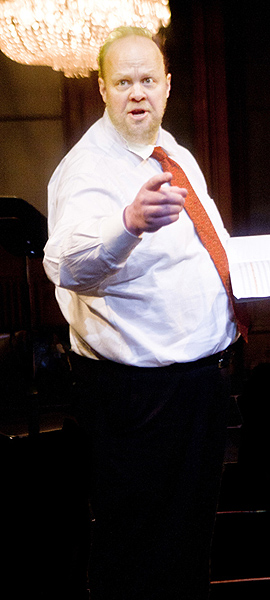
Fifteen years ago, composer Eric Salzman stumbled across a man who caught his attention.
He was powerful, charming, persuasive and alarmingly wealthy. He made his fortune by promising to grant other people’s fantasies, offering them an alternative, virtual reality with a simple headset.
It was a lie. And as quickly as he appeared on the scene, the Los Angeles-based con artist disappeared without a trace, leaving in his wake a small army of infuriated investors, their broken dreams, an endless stream of national headlines and the idea for an opera.
“I don’t remember the real con man’s name, it was many years ago,” Mr. Salzman, a longtime East Quogue resident, explained during a telephone interview last week. “You know these con man stories appear regularly, one more fantastic than the other, so it always seems like a current topic.”
Thanks to the national press reports, Mr. Salzman had the story but needed help writing it. He turned to his friend, Ned Jackson, who came back to him with a 200-page libretto entitled “Big Jim & the Small-Time Investors.”
“It was astounding,” Mr. Salzman recalled. “I didn’t want to run him down because it was brilliant, but if I said every word, it would have been longer than Wagner. It would have gone on for a week.”
Equally frustrated and saddened, Mr. Salzman cast the opera aside as “unmanageable,” he said. Until now.
After boiling down “Big Jim” and receiving a positive reception during the Center for Contemporary Opera’s libretto reading last spring at The Flea Theatre in Manhattan, the composer has breathed new life into “Big Jim” and is now raising funds through USA Projects, a nonprofit grantmaking and artist advocacy organization that helps them navigate the world of online fundraising, to bring it to the stage. The 79-year-old composer said he hopes it will be his biggest, and freshest, “music theater” production yet.
Marked by modest cast sizes and music heard without pause throughout, Mr. Salzman’s music theater works walk the line between grand opera and Broadway musicals, he said. In today’s economy, the future of theater lies in economically viable, small-scale works with music as the driving force, he added, and that is what he’s delivering.
“You can call it ‘Broadway opera’ or ‘small-scale opera.’ I don’t like the word ‘opera’ particularly. I’ve sort of fought against it, but I’ve given up,” he laughed. “It has too many connotations to me. It carries a lot of baggage. On the other hand, I don’t do musicals either. I use the term ‘music theater’ to separate it. Musicals aren’t what they used to be.”
So long as Mr. Salzman collects between $10,000 and $15,000 through his fundraising by May for revisions, completion of the musical composition, choral arrangements and orchestration, the Center for Contemporary Opera, where he is artistic director, has agreed to stage “Big Jim” in 2014. Any overages would be donated to the non-profit’s production costs, he said.
“At some point, 2014 seemed far away,” he said. “It doesn’t seem far away anymore. It’s a tough time to try to raise money for big arts projects. Maybe things will be getting better now, but it hasn’t been easy. But the money goes very far and helps to encourage an art form that really deserves to be supported. It’s an art form of the future because grand opera and the musical are not very innovative. This is where the innovation and new and exciting stuff is happening.”
When it comes to “Big Jim,” its creator has two conflicting visions. He can visualize the opening scene. The small investors break into the con man’s lavish house demanding to know where he is and what he did with their money, only to find an empty home all but for a television playing a video of him explaining why he had to do what he did.
In the production, the audience is literally standing by as small-time investors themselves, watching the whole story unfold from within the house.
According to Mr. Salzman’s USA Projects page, Big Jim’s climb to fame and power as a dot.com televangelist is shown in a series of flashbacks: his rise from obscurity, his ability to lure people into his scheme, his marriage to a beauty queen, his dabbling in politics, his downfall and disappearance.
The very electronic media he exploits is used to tell his story—via either a television or a different reincarnation, which is Mr. Salzman’s second idea.
In this version, the venue is a conventional theater. And Big Jim is nothing but a hologram.
“I think that would be extremely interesting, having him sing live backstage and seeming to interact with the actors in this way, this technology,” Mr. Salzman said. “It’s been done in dance duets, when one of the partners is a hologram, but I don’t think it’s been done in opera yet.”
To make a contribution toward “Big Jim & the Small-Time Investors” or for more information, visit usaprojects.org/project/big_jim_the_small_time_investors.